Energy to Go

What should runners eat?
Runners can run out of fuel easily. “All endurance athletes need more macronutrients, vitamins and minerals than the average person,” say Shalane Flanagan, marathoner and Olympic medalist, and Elyse Kopecky, authors of “Run Fast. Eat Slow” (Rodale Books, 2016). Which is why they should take extra care not to run on empty when it comes to diet.
How should runners eat to ensure health and peak athletic performance? Flanagan and Kopecky, as well as Mitzi Dulan, RD, CSSD, author of “The Pinterest Diet” (Dulan Health, 2013) and Heather Mangieri, MS, RDN, CSSD, LDN, author of “Fueling Young Athletes” (Human Kinetics, 2016) all stress that runners, like everyone, should eat a healthy, balanced diet of fresh whole foods. It’s easiest to do this, Flanagan and Kopecky say, if you cook for yourself. “Other than running more miles, the single greatest thing an athlete can do to improve their performance (and long-term health and happiness) is to learn to cook,” they say.
What should runners include in their diet?
Mangieri says to consider nutrients rather than ingredients. While total carbohydrates are a fuel source for runners, she says, Vitamin D and calcium help maintain a strong skeleton. Iron and B12 are key because a deficiency of either would result in fatigue. Flanagan and Kopecky point out the key role of good fats, which help fight inflammation and repair the body. “Don’t fear fat,” they say. “A balanced diet rich in good fats is essential for bone, hormone, heart and brain health and a healthy metabolism.”
Mangieri attests to the primary role of protein. “Runners tend to use about 10 to 15 percent of the protein they consume as energy. Therefore, their daily need is slightly higher than for non-athletes,” she says. “Still, most Americans are getting plenty. Rather than increasing intake, it’s important to make sure that protein intake is spread evenly throughout the day. Doing so increases the protein efficiency and helps to maximize muscle protein synthesis.” For sources, Dulan suggests chicken, salmon and pork tenderloin. (She also encourages consumption of antioxidant-rich produce, such as bananas, apples, pineapples, watermelons and grapes.)
Which meals and snacks should runners eat every day?
For breakfast, Flanagan goes for a whole-milk yogurt bowl with muesli and fruit or an egg scramble with spinach, avocado and parmesan (with buttered whole-grain toast on the side). For lunch, she’ll choose a hearty grain salad, such as quinoa, wild rice or farro with seasonal vegetables, greens, nuts and an olive-oil-based dressing. At dinnertime, she’ll pair a favorite protein, such as steak or roasted chicken, with roasted vegetables, sweet potato fries and salad. Flanagan snacks on nuts and dates, muffins, smoothies, or bananas or apples with nut butter. Snackwise, Dulan suggests a combination of protein, carbohydrates and healthy fats, as with protein balls and kefir and Greek yogurt drinkables.
What should runners eat before, during and after a run?
“The best pre-event or training foods will be low in fat and fiber and adequate in carbohydrates and fluids,” Mangieri says. The night before an endurance event, Flanagan will eat salmon, a hearty salad with grains, sweet potatoes and bread with butter. The next morning, she’ll go for protein, carbohydrates and a small amount of fat, usually in the form of coffee with creamer, GU Brew (an electrolyte drink) and her Race Day Oatmeal (recipe below) with a banana, creamer, walnuts, almonds, berries and honey. During marathons, Mangieri recommends engineered foods with carbohydrates, electrolytes and fluid, such as sports drinks, energy gels, chews, beans and “bloks.”
With sprints, Mangieri points out, carbohydrates are the primary fuel source. She recommends opting for simple forms, such as sport drinks, carbohydrate gels/chews/bloks, fruit, graham crackers and fig bars. “They will digest quickly and provide a quick source of fuel,” she says. When sprinting, Flanagan reaches for bread, fruit and sweet potato breakfast cookies. Post-marathon, she tends to go for a burger and fries, such as the Greek Bison Burger (recipe below) and sweet potato fries from her book. “It’s important to celebrate every race,” she says.
Which foods should runners avoid?
Dulan, Flanagan and Kopecky agree on steering clear of artificial sweeteners. Flanagan and Kopecky add soda, highly processed packaged foods and sugar to the no-go list, although Flanagan admits, “I limit my consumption of sugar, but I don’t completely avoid it. I love dark chocolate. In a healthy diet, there is room for indulgences, but most of mine are wholesome homemade treats.”
How much should runners eat?
Regardless of diet, consume the right amount. “Runners need the same balanced diet day to day that non-runners need—they just may need more,” Mangieri says. “As a rule of thumb, their extra carbohydrate calories are specifically to support their increased energy expenditure. Therefore, whether they need extra fuel to support their running will depend on the duration and intensity of their training. For the most part, training for a 5K will not require any extra calories; the longer runs will.” Still, “stop counting calories,” Kopecky and Flanagan advise. “Instead, eat mindfully and get back in touch with listening to your body’s hunger signals.” That way, you’ll be off to a running start!
Photo credit: Alan Weiner